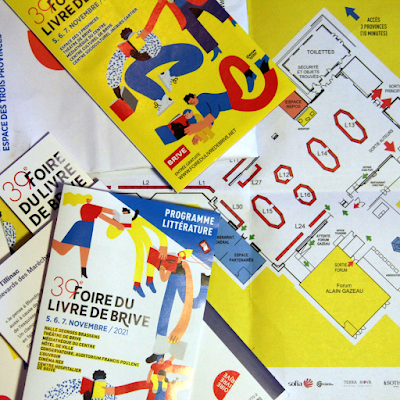 |
| The landmark Gare des Bénédictins. |
Once outside, you can appreciate its distinct 60 meter high clock tower and adjacent park with its fountains. Though the station opened in 1929, the design of its structure predates the art-deco ideas, and was revolutionary because it was build over the railway lines, instead of next to them. The result was a very large hall topped with a metal dome and copper roof.
The interior is art-deco inspired by the Limousin: chestnut and oak leaves in the metal work, statues dedicated to the four provinces served by the station and references to the world famous Limoges' porcelain industries.'
 |
| Map of Limoges. |
Leaving the station behind you will find Limoges a surprisingly walkable'city, the third city in France to be awarded the full 'four leaves' under the Ville Fleurie label: the fountains of the Champ de Juillet are the first of 18 and the park only a small part of the 680 ha of maintained green spaces and over 300 protected remarkable trees in the urban environment. Turn left at the end of the park to reach the tourist office via the Place Jourdan to pick-up a city map, or walk straight to the historic centre of the Ville Haute. Even with a map you should prepare for some searching as the plan does not follow a modern grid.
 |
| Les halles centrales. |
 |
| The Verdurier pavilion. |
 |
| A must-visit is the butchers quarter. |
 |
| The Saint Etienne cathedral on the bank of the Vienne river. |
From the 'Ville Haute' it is a small walk to a second historic area surrounding the Saint Etienne cathedral(7) on the bank of the Vienne river. Wood-framed houses flank the streets that lead uphill towards to the cathedral,Musée de Beaux-Arts and the botanical gardens (8). In 1370 the Cité opened its gates to the ‘French’ (Capetian) whiles the city stayed loyal to the Angevin (‘English’), this did not end well for the Cité that was largely destroyed after a siege.
 |
| Musée de Beaux-Arts and the botanical gardens. |
 |
| Colorful and elaborately decoration of the Saint Etienne cathedral. |
This part of the river banks was ones the place were 'rafts' made of wood from the upstream forested areas would arrive for use in the large numbers of porcelain kilns that produced the world famous 'Limoges'.
 |
| There are a number of producers within the city. |
Many references in the street and buildings, market, exhibition, kilns. Though the number of kilns has gone down and the use of charcoal has stopped, a select number still thrive. The kiln of Casseaux was constructed in 1884 and operated till 1995. The kiln and factory were declared a national (industrial) heritage and transformed into a museum.
 |
| Musée National Adrien Dubouché. |
Bernardaud (27, avenue Albert Thomas), Bruno Mercier (1, boulevard Louis Blanc), Harviland – Pavillon de la porcelaine (3, avenue du Président Kennedy), Morpho blue (14 rue de la Boucherie), Perl porcelaine et recherche de Limoges (9, boulevard Louis Blanc), Porcelaine Arquie Limoges (3, rue Font Pinot), Porcelaines Lachaniette (27, boulevard Louis Blanc), Raynaud Limoges (14, ancienne route d'Aixe), Salamandre – Porcelaine de Limoges (5, rue Haut Cité).




No comments:
Post a Comment